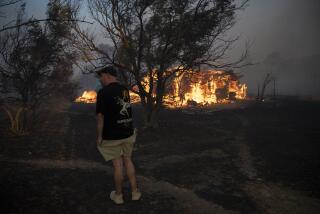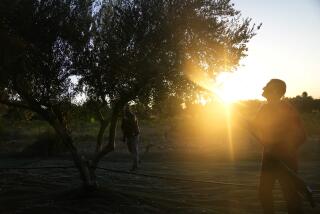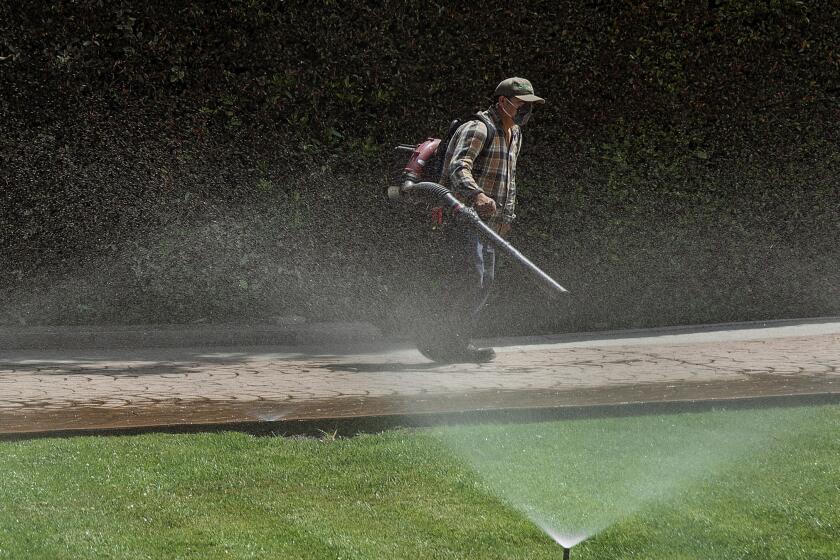Suburban Sprawl Sapping Mediterranean’s Water
- Share via
ST. TROPEZ, France — All through the fires of a long hot summer, as black smoke blotted out herb-scented hills of the Cote d’Azur, the steady whump-whump of lawn sprinklers never missed a beat.
Grapevines died of thirst and sun-baked olive trees languished on outlying farmland, yet behind the gates of St. Tropez villas, lush green grass grew so thick that mushrooms poked through.
At Parc de St. Tropez, where 150 vacation homes sit by the sea, uncontrolled private wells tap a fast-dwindling aquifer, saving city water charges. One estate of rolling gardens has five wells.
In town, classier cafes air-condition outdoor tables, a la Palm Springs, spraying mists of cool water from overhead jets.
The extremes are evident here in Brigitte Bardot country, where cascades of vibrant bougainvillea are as much a trademark as bare bosoms on the beach. But St. Tropez is hardly unique.
From Gibraltar to Greece, rampant construction and runaway development are making over the face of the Mediterranean, bringing ecological catastrophe to ancient ways of life.
At a pace that is sometimes even greater than in the American Southwest, burgeoning populations with ever-growing water demands are upsetting a delicate balance.
All year long, families from Europe and beyond move into new homes equipped with swimming pools and gardens full of exotic plants.
In some places, irreplaceable underground fossil water, hundreds of thousands of years old, is squandered and natural vegetation is permanently lost.
In others, the sprawl of cheap subdivisions and bleak high-rises stamps out cultural heritage that dates back to ancient Phoenicians and Romans.
“It can’t go on like this very long,” said Samy Maasaoui, a water dowser who each day sees more similarity to the moonscapes of North Africa, from which his well-digger father emigrated.
To him, southern France is a bellwether for a future world. When water gets scarce, he expects it to go to the highest bidder. And those who can afford it are likely to waste it.
“Twenty years ago, we could almost always strike water at 20 or 30 meters [about 60 to 90 feet],” he said. “Now, it’s not unusual to pass 160, 200 meters and find nothing.”
Greek Environment Minister Vasso Papandreou told a recent European Union meeting that neither the public nor governments seemed to realize the urgency of managing water and growth.
“Not only in Greece but also everywhere else, if anyone worries about the danger, they believe it is something for the distant future,” she said. “This is a big problem.”
A dwindling water supply is one crisis for some of the most gentle and generous landscapes on the planet. Another is the speculators and developers who are paving over paradise.
Hillsides are ripped away to make way for golf courses, greenhouse farming and communities that include thousands of homes. Freeways and high-speed rail tracks slice through ancient fields.
According to the World Conservation Union, about 115,000 square miles of the European Mediterranean are turning to desert because of mismanagement and overexploitation. This affects the livelihood of 16.5 million people, not counting the millions more who converge on the region each summer, it says.
John Thorne of King’s College in London conducted a decade-long survey of Mediterranean desertification for the European Community, and found the same local patterns repeated on a grand scale.
“This pace of development is simply not sustainable,” he said in an interview. In parts of Spain and Italy, damage from soil erosion is already irreversible, Thorne said. Ecosystems are changing. The extremes near Murcia in southern Spain “are so horrendous, they’re off the map,” he said.
Julia Martinez of the University of Murcia avoids the term “desertification” because it suggests a natural process. “The trouble is not nature; it is people,” she said.
Soil erosion plagues large areas of badlands, Martinez said, but the most costly damage is from paving over rich lands near rivers and canals, and stripping once-productive hillsides.
The warm, dry days feed a huge leisure and retirement industry, comparable to the U.S. Sun Belt. As the EU erases internal boundaries, northern Europeans can borrow money at home for a private haven or take a job with no visa needed.
Americans come to settle under the Tuscan sun or spend their year in Provence. Russian mobsters pay bags of cash for property on the Spanish coast or French Riviera.
St. Tropez’s year-round population remains steady near 6,000, but up to 6 million visit the area each year -- many coming to their second homes. The coastal region of Languedoc-Roussillon is growing three times faster than the rest of France.
Spain now outranks France as the most popular destination for Europeans on vacation -- more than 50 million a year -- and most of those are headed for the Mediterranean.
Newcomers disrupt complex Mediterranean systems of irrigation canals, firebreaks and winter sheep pastures that have sustained family farms for millenniums.
Huge supermarkets and furniture outlets line broad new roads. Golden arches announce fast food for people too hurried to dawdle over daube or pistou.
John Wainwright, an erosion specialist at King’s College, said destruction of old terraces and catchments means that topsoil built up over centuries can wash away in a single season.
Also, he said, overuse of aquifers near the coast is causing seawater to penetrate in a number of places, polluting the underground reservoirs.
Roger Martin’s family has watched the change over at least six generations, farming and tending olives near the village of Ampus, north of here.
“We have lost our contact with the land, with the sense we all had that this is fragile country which we must work together to protect,” Martin said.
While scientists have come slowly to agree that global warming and abrupt weather patterns are real, old-timers like the Martins have watched the reality up close.
Farmers all along the Mediterranean know that the vital question is not total rainfall but its pattern: how much falls when, and at what intensity. Season after season, the answers are unsettling.
Martin’s son, Eric, oversees 3,000 olive trees at an estate north of St. Tropez. After the trees struggled through the hottest summer in memory this year, a hailstorm stripped them bare.
Now his wife, Lucie, fears that her annual truffle hunt will also be a disaster. Experts predict that the Mediterranean winter harvest of the treasured black fungus will be 70% less than last year’s.
As in the United States, drying forests are in peril. Helped by arsonists and careless residents, fires destroyed tens of thousands of acres in France this summer, including huge expanses near St. Tropez.
In France and Italy alone, the loss to farmers may approach $10 billion.
Over the winter, it was floods. Deluges overflowed built-up riverbanks and ran off vast paved areas that once absorbed heavy rainfall. Dozens of people were killed, and old farms were washed away.
France is far better off than Spain or Italy. The 505-mile Rhone waters its center, snow from the Alps and Pyrenees feed aquifers, and the Canal de Provence supplies much of the south.
Still, stark pictures suggest a fearful future.
Treille, perched on a mountain near Marseille, is where Marcel Pagnol imagined his classic novel “Jean de Florette.” In it, a girl done wrong paralyzes the village by blocking off its spring.
Today, unblocked, the spring emits a mere trickle. A nearby village’s 200-year-old chestnut tree just died because the water table is too low for its roots.
Rhone Valley farmers may have plenty of water, as do those along well-maintained irrigation canals. But where the land starts to climb, they are dependent on groundwater wells.
Even when water remains at its old levels, the demand is often so much higher that sources simply run dry. With the balance so precarious, drought can spell calamity.
By midsummer, the Po, which waters much of northern Italy, had dwindled to a trickle. Most European rivers suffered. The Danube dropped so low that scuttled German tanks from World War II suddenly surfaced.
Pressure on the land has worsened in recent years because European Union subsidies encourage water-intensive agriculture in places too dry to support it.
And now, global weather patterns are compounding the damage with alarming regularity.
Geoff Love, an Australian who just left the U.N. World Meteorological Organization after years as secretary of the 1,500-member Intergovernmental Panel on Climate Change, is worried.
“We’ve reached the point where we are modifying the climate, and we have to manage the impact because we have taken out the major feedback systems,” he said. “Nature can’t take care of itself.”
For example, he said, land erosion and dried-out fields are forcing animals to migrate north, but they are blocked by freeways and new construction. As a result, many die.
Wild fruits and plant species are vanishing in places where they once flourished.
Love predicted that the climate-change panel’s fourth assessment, due in 2007, would focus on regional rather than planetary warming, and he called the northern Mediterranean an area of serious concern.
“This is a grinding, slow, drying-out process,” he said. At the same time, he added, “when change occurs, it is with dramatic extremes.” In short, he said, droughts and floods may be routine.
Experts discuss such solutions as channeling water off the Rhone to supply Catalonia in Spain. But even then, only users connected to a grid would benefit. Isolated areas would suffer.
Coastal regions might build plants to desalinate sea water. But these require valuable seaside land and large investments, and can’t provide enough water for agriculture.
The only real answer, specialists say, is what is already being done across the Mediterranean in North Africa: to find ways of sharing water among cities, vacation complexes, farms and industrial users. But people who work every day at the practical level are dubious.
In the Kef region of Samy Maasaoui’s native Tunisia, villagers adopted a system to parcel out water from their mountain source. It worked well, even during drought and famine, supervised by a trusted elder.
Then a farmer caught his neighbor manipulating the valves. He and his son settled the dispute with a shovel, bashing the neighbor to death.
“It may not come to that here,” he said. “But when it comes to water, people are seldom reasonable.”
At Benidorm, on Spain’s Valencia coast, millions of British and other visitors return each year. Many call it vacation heaven. But others, who avoid Benidorm, describe the place in unprintable terms.
Benidorm spreads along the best sand beach in Europe, a five-mile stretch from the forbidding gray tower of the New Bali Hotel, with 765 rooms, to the side-by-side McDonald’s and Burger King at the end.
Deputy Mayor Manuel Perez Fenoll told reporters on a recent trip to promote Benidorm: “We have no plan to limit growth. Only the free market should determine tourist development.”
Benidorm’s Aqualandia park exudes that attitude. Crowds ride artificial surf, frolic under waterfalls, swim in a lake-sized pool and plummet down towering flumes, happy as if there were no tomorrow.
More to Read
Sign up for Essential California
The most important California stories and recommendations in your inbox every morning.
You may occasionally receive promotional content from the Los Angeles Times.













